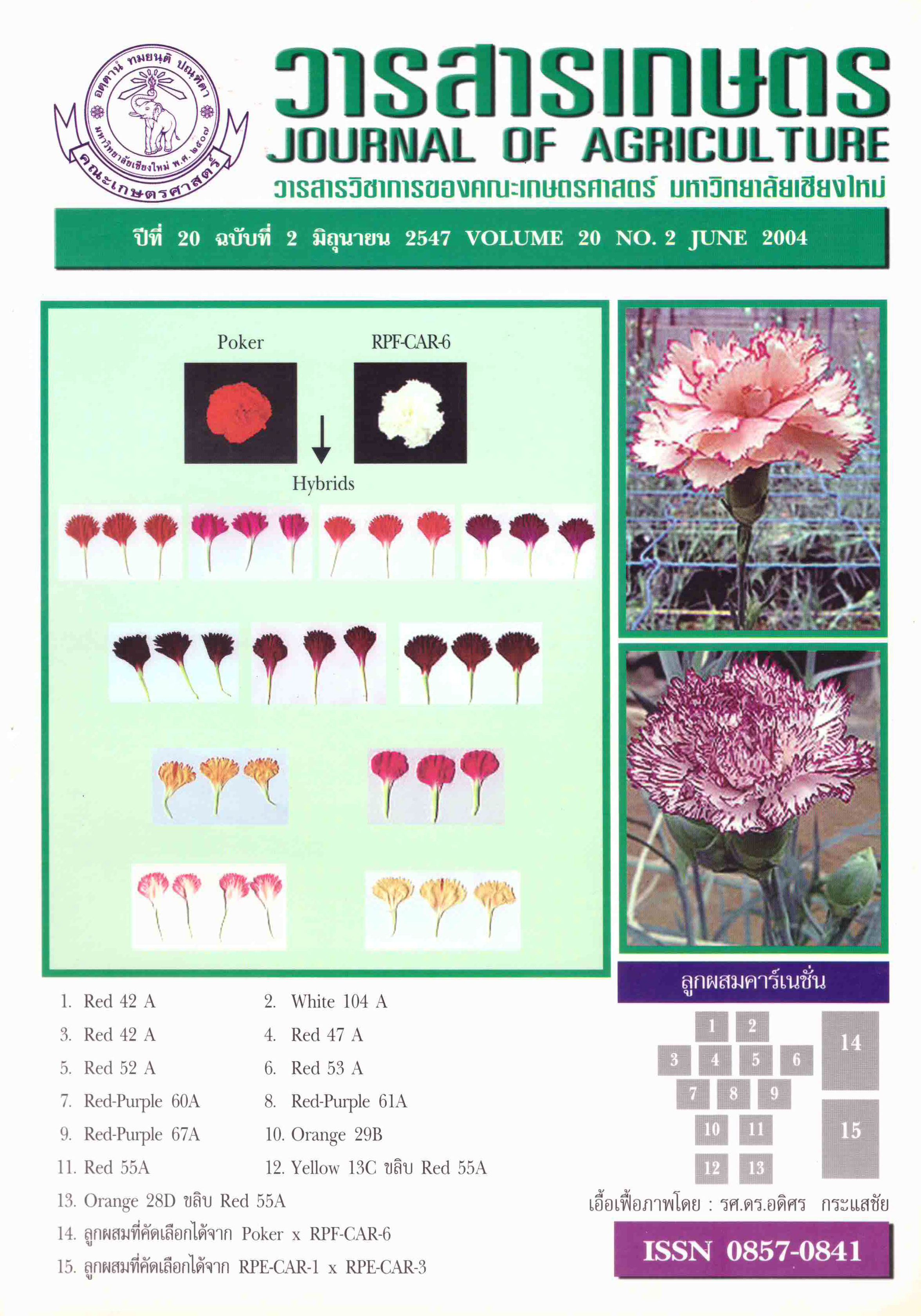Field Monitoring of Cruciferous Insect Pest Populations by Synthetic Sex Pheromone Traps in Chiang Mai Cauliflower Production Areas
Main Article Content
บทคัดย่อ
Field monitoring of the diamondback moth (DBM), Plutella xylostella (Linnaeus) and the common cutworm (CW), Spodoptera litula (Fabricius) adult insect populations by the synthetic sex pheromone traps were conducted during 1995-1997 cauliflower growing seasons at Sarapee, Chiang Mai, to determine the densities and population dynamics of the insect pests in correspondence with the meteorological data. The total area of study was 800 m2 (0.8 ha) and was divided into thirty plots of 5 m long and 2 m wide, the crop spacing was 30x30 cm, and there was a total of 75 cauliflower plants on each plot. The DMB population attained its first peak of 819 insects on January 2, 1966, during the harvest time of the third cropping of the 1995 growing season, then remained low through the first cropping of the 1996 growing season. The population then reestablished and reached the second peak of 859 insects on March 5, 1966, and continued diminished through the second crop plantation with a small peak of 279 insects during the mid harvest time. The adult insects of less than 100 insects per sampling date were detected through the third crop plantation, then sharply increased and attained a triple peak of more than 500 insects, during the first crop plantation of the 1997 growing season. The DBM population had never exceeded 330 insects through the rest of the field trial. The CW population continued increased during the first six sampling dates then attained the maximum peak of 1,465 insects on December 12, 1995. The adult population reached a triple peak of more than 600 insects per sampling date during the second crop plantation, then remained low through the rest of the study, never exceeded 370 insects per sampling date.
Although the meteorological factors including the temperature, relative humidity, and the rain precipitation displayed inconsistently correlated with both the DBM and the CW populations, the rainfall seemed to exert the negative correspondence with the DBM adult population. This insect population exhibited persistently declined through the rainy seasons of both the 1996 and 1997 growing seasons.
Article Details
เอกสารอ้างอิง
Kitamura, C., and M. Kobayashi. 1985. A comparison between communication disruption and mass trapping methods in mating suppression effect of a synthetic sex pheromone to Spodoptera litura F. (Lepidoptera: Noctuidae). Appl. Entomol. Zool. 20 : 222-224.
Nemoto, N., E. Yano, and K. Kiritani. 1992. Pheromonal control of diamondback moth in the management of crucifer pests. pp. 91-97. In: N.S. Talekar, (ed.), Proceedings of the Second International Workshop on Diamondback Moth and Other Crucifer Pests. AVRDC Publication No. 92-368. Asian Vegetable Research and Development Center, Shanhua, Taiwan.
Ohbayashi, N., K. Shimizu, and K. Nagata. 1992. Control of diamondback moth using synthetic sex pheromone. pp. 99-104. In: N.S. Talekar, (ed.), Proceedings of the Second International Workshop on Diamondback Moth and Other Cruciform Pests. AVRDC Publication No. 92-368. Asian Vegetable Research and Development Center, Shanhua, Taiwan.
Ohno, T., T. Asayama, and K. Ichikawa. 1992. Evaluation of communication disruption method using synthetic sex pheromone to suppress diamondback moth infestations. pp.109-114. In: N.S. Talekar, (ed.), Proceedings of the Second International Workshop on Diamondback Moth and Other Crucifer Pests. AVRDC Publication No. 92-368. Asian Vegetable Research and Development Center, Shanhua, Taiwan.
Rushtapakornchai, W. 1992. Insect pests of cruciferous vegetable and their management. pp.142-452. In: S. Ruay-aree, (ed.), Major Insect and Animal Pests of Economic Plants and Their Management. Technical Bulletin. Division of Entomology and Zoology, Department of Agriculture, Bangkok. (in Thai)
Rushtapakornchai, W., A. Vattanatangum, and T. Saito. 1992. Development and implementationof the yellow sticky traps for diamondback moth control in Thailand. pp.523-528. In: N.S. Talekar, (ed.), Proceedings of the Second International Workshop on Diamondback Moth and Other Crucifer Pests. AVRDC Publication No. 92-368. Asian Vegetable Research and Development Center, Shanhua. Taiwan.
Shelton, A.M., and J.T. Trumble. 1991. Monitoring insect population. pp.45-62. In: D. Pimentel, (ed.), CRC Handbook of Pest Management in Agriculture. 2nd ed. Vol. II. CRC Press, Inc., Boca Raton, Florida.
Tamaki, Y., K. Kawasaki, H. Yamada, K. Koshihara, N. Osaki, T. Ando, S. Yoshida, and H. Kakinohara. 1977. (Z)-11-hexadecenal and (Z)-11-hexadecenyl acetate: sex-pheromone components of the diamondback moth (Lepidoptera: Plutellidae). Appl. Entomol. Zool. 12: 208-210.
Wakamura, S., and M. Takai. 1992. Control the beet armyworm in open field with sex pheromone. pp.115-125. In: N.S. Talekar, (ed.), Proceedings of the Second International Workshop on Diamondback Moth and Other Crucifer Pests. AVRDC Publication No. 92-368. Asian Vegetable Research and Development Center, Shanhua, Taiwan.
Wongsiri, N. 1991. List of Insect, Mite, and Other Zoological Pests of Economic Plants in Thailand. Technical Bulletin. Division of Entomology and Zoology, Department of Agriculture, Bangkok.


